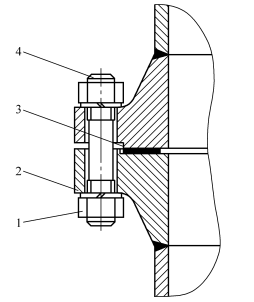- Home
- >
- Technology
- >
- Gasket sealing principle and leakage form
Gasket sealing principle and leakage form
Gasket sealing principle and leakage form
Basic concept of gasket seal
Gasket sealing is the main sealing structure form of removable joints such as pressure vessels, process equipment, power machines and connecting pipes in industrial devices. It is usually composed of flanges, gaskets, connecting bolts and nuts, which is generally called flange sealing joints. The structural form of flange sealing joint is shown in Figure 1.

Fig. 1 structural form of flange sealing joint
1-nut 2-flange 3-gasket 4-bolt
Gasket sealing mechanism
Leakage is the phenomenon that the medium flows from the inside of the limited space to the outside, or enters the inside of the limited space from the outside. The medium flows through the interface of internal and external space, that is, the sealing surface leaks. The root cause of leakage is the gap on the contact surface, and the pressure difference and concentration difference on both sides of the contact surface are the driving force of leakage. Due to the influence of the form and machining accuracy of the sealing surface, the sealing surface is not completely consistent, that is, there will be a gap on the sealing surface, resulting in leakage. To reduce leakage, the contact surface must be embedded to the greatest extent, that is, reduce the cross-sectional area of the leakage channel and increase the leakage resistance to make it greater than the leakage driving force. Applying pressure and tightening load to the sealing surface can produce compression stress and improve the contact degree of the sealing surface. When the stress increases enough to cause obvious plastic deformation on the surface, the gap of the sealing surface can be filled to block the leakage channel. The purpose of using gasket is to fill the small unevenness of flange sealing surface with the help of the characteristics that gasket material is easy to produce plastic deformation under the action of compression load, so as to realize sealing. In the flange sealing joint, the force of pressing the gasket deforms the gasket material, so as to fill the micro gap between the flange sealing surfaces.
Leakage form of gasket seal connection
Gasket is the main sealing element in flange sealing joint. For the non-metallic gasket, the sealing of the connection causes large compression stress on the contact surface between the flange and the gasket and inside the gasket by tightening the bolts. On the one hand, it makes the gasket surface closely fit with the flange surface to fill the micro gap on the flange surface, on the other hand, it reduces the porosity of the gasket material, that is, it reduces the leakage channel of the sealed fluid. Because any processing method can not form an absolutely smooth ideal surface, nor can it realize the complete fitting between the sealing surfaces and the complete blockage of the pores of the seal itself, there is always a small gap or passage between the sealing surfaces in contact with each other and inside the seal. Therefore, for gasket seal, leakage is always inevitable. When the medium passes through the bolt flange connection with a certain pressure, there will always be leakage at the sealing point. By analyzing this phenomenon, it can be found that the leakage occurs in two forms, namely "interface leakage" and "penetration leakage", as shown in Figure 2.
1. Interface leakage
Insufficient gasket compression stress, rough flange sealing surface, thermal deformation, mechanical deformation and vibration of the pipeline will cause leakage due to loose fit between gasket and flange sealing surface. In addition, under the operating conditions, due to the action of temperature and pressure, the bolt deformation and elongation, the creep relaxation and rebound capacity of gasket, and the aging and deterioration of gasket materials will also cause leakage between flange and flange sealing surface. This kind of leakage between gasket and flange sealing surface is called "interface leakage".
2. Seepage and leakage
Non metallic gaskets are usually made of plant fiber, animal fiber, mineral fiber or chemical fiber bonded and pressed with rubber, or made of porous materials such as flexible graphite. Due to its loose structure, poor compactness and countless tiny gaps between fibers, it is easy to be soaked by the medium, especially under the action of pressure, the medium will penetrate through the pores in the material. This leakage inside the gasket material is called "penetration leakage".

Figure 2 "interface leakage" and "penetration leakage"




;)
;)




